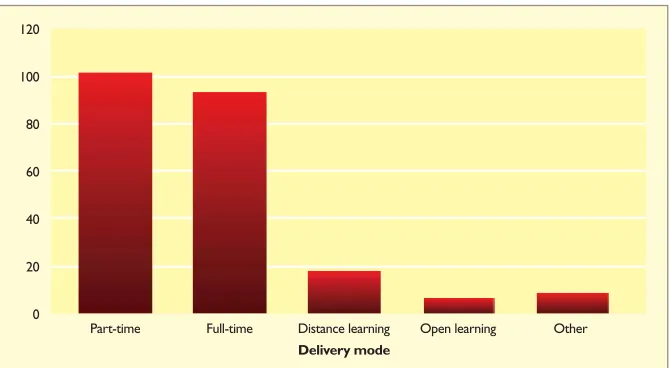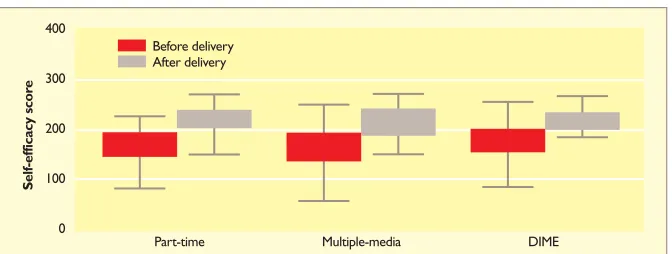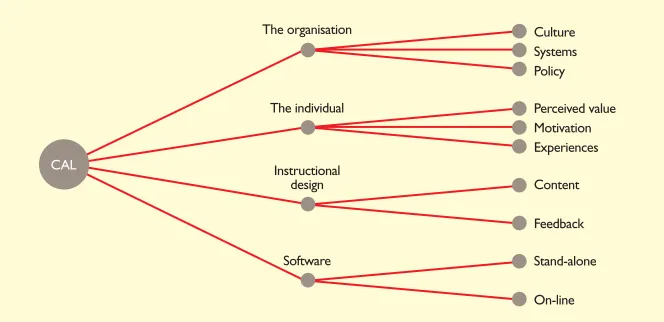Elearning for project management
Ellis, R, Thorpe, T and Wood, GD
http://dx.doi.org/10.1680/cien.2003.156.3.137
Title
Elearning for project management
Authors
Ellis, R, Thorpe, T and Wood, GD
Type
Article
URL
This version is available at: http://usir.salford.ac.uk/37293/
Published Date
2015
USIR is a digital collection of the research output of the University of Salford. Where copyright
permits, full text material held in the repository is made freely available online and can be read,
downloaded and copied for noncommercial private study or research purposes. Please check the
manuscript for any further copyright restrictions.
For more information, including our policy and submission procedure, please
Robert Ellis
is a teacher fellow at Leeds Metropolitan University
Tony Thorpe
is head of Civil and Building Engineering at Loughborough University
Gerard Wood
is a senior lecturer at University of Ulster
A decade ago ‘multimedia’ was the buzz word in the computing world. At the time, academics were predicting that such technology would revolutionise teaching, releasing the tutor from the lecture the-atre.1The vast majority of courses were
largely unaffected by such ‘technological wizardry’ due, primarily, to the high costs associated with computer-aided learning development. Today, however, there is an abundance of authoring packages2and
many affordable off-the-shelf educational multimedia products3from which to
choose. Moreover the internet, once the preserve of researchers, has become main-stream, finding applications in many walks of life.
A review of project management educa-tion literature suggests that there is an increasing interest in ‘outreach’ or physi-cally remote training and education pro-grammes aimed at satisfying the needs of the lifelong learner. Examples of novel delivery methods abound as academics follow current trends in higher education towards resource-based learning, either in distance learning or supported self-study mode.4Yet there remains doubt as to the
extent of computer-aided learning
devel-opment.5Are such initiatives small-scale
and isolated examples created by enthusi-asts or far-reaching approaches that are common to many programmes through-out the UK?
UK postgraduate course delivery
Recommendations that project manage-ment education should primarily be deliv-ered at postgraduate level6prompted a
survey of UK-based built-environment masters programmes to establish the nature and extent of course delivery.
The responses of 129 academics (repre-senting the views of approximately 60% of the built-environment courses identi-fied in theIndependent’spostgraduate listings),7demonstrate that the availability
of distance learning is small (Fig. 1). Only 14% of courses in the sample were avail-able in distance-learning mode, of which about half used some form of computer-aided learning. The cost of development together with the maintenance and administration of distance-learning pro-grammes were cited as being key issues. But the principal reasons for opposing such development were the perceived
This paper examines the reasons for the apparent reluctance
of civil engineers and other construction professionals to use
computer-aided learning on distance-learning programmes and
reports on the evaluation of a project-management CD-ROM.
It concludes that ‘e-learning’ can be as effective as traditional
distance learning and face-to-face teaching, but is best suited to
the development of ‘hard’, technically oriented, project
management skills than ‘soft’ interpersonal skills.
ELLIS, THORPE AND WOOD
138
C I V I L E N G I N E E R I N Gteaching limitations inherent in all forms of distance learning.
The view of one respondent was typical
‘Peer group learning and discussion is vital for the development of under-standing and the testing of hypotheses in our field whereas distance learning students learn alone or in partnership with just a tutor. Our students learn from one another face-to-face.’
The implication was that distance learn-ing promoted a bureaucratic mentality that was inappropriate in courses that were intentionally discursive. This study attempts to test this view by examining the experiences of students and practition-ers studying project management at a postgraduate level.
Methods and materials
A well-established postgraduate module delivered in part-time mode was compared with a multiple-media distance-learning resource and a new distance-learning pro-ject management educational software application (DIMEPM) to establish the
effectiveness of distributed interactive multimedia (Fig. 2).
Traditional part-time delivery was characterised by seven three-hour taught sessions, which relied heavily on class-room-based, hands-on activities. The multiple-media distance-learning equiva-lent comprised a one-day induction event where students were introduced to key topic areas and issued with a range of learning resources: printed guides, ‘read-ers’, videos, audio-tapes and spreadsheet applications. The software package inte-grated the variety of media on a single CD-ROM and also provided links to a virtual learning environment with on-line learning resources.
Both the outcomes and content in each delivery mode were identical, the dis-tance-learning material having been writ-ten by academics and practitioners who contributed to the part-time delivery of the module. In essence the twelve-credit module reviewed key project management tools and techniques—that is, value man-agement, risk management and critical path analysis—and also emphasised the importance of interpersonal skills. Over a
period of two years the three students undertook the module in different study modes and their experiences and perfor-mance were monitored.
Kirkpatrick’s8work provided a useful
model for the evaluation of each delivery mode, both from an academic and an industry perspective. The model compris-es four levels, namely reaction, learning, application and results. Results encom-pased user feedback, learning gain, work-place performance and organisational improvement, and in this evaluation, relied upon a combination of data capture methods to collect the necessary data (Table 1).
In common with other evaluations, however, it became increasingly difficult to collect data in the latter stages of Kirkpatrick’s model and the fourth level was excluded from the evaluation.
[image:3.595.219.554.162.346.2]Instead an illuminative case study was undertaken so as to collect the views of
Fig. 2. Project management learning resources: (a) part-time; (b) multiple-media; and (c) distributed interactive multimedia
Level of evaluation Data capture method
Reaction Interest and involvement charts9
Learning Pre-test, post-test
Application Self-efficacy
Results Industry-sponsored case study
Table 1. Data capture methods
The software
package
integrated the
variety of media
on a single
CD-ROM
Delivery mode
0 20 40 60 80 100 120
Part-time Full-time Distance learning Open learning Other
Fig. 1. Responses from 129 UK academics show that distance-learning accounts for only a small proportion of postgraduate course delivery in the built environment
(a) (b) (c)
[image:3.595.221.552.393.485.2]practitioners on the organisational impact— that is, results—of computer-aided learning in the workplace. Whereas this might be construed as a break in the cause-and-effect chain,10the ethical and logistical problems
encountered in determining the extent to which the organisational improvement had occurred were prohibitive.
Findings over two-year period
Reaction
Over the two-year period, 126 students took part in the evaluation of the three delivery modes. Personal interest and involvement was recorded throughout the module via interest and involvement charts
which were summarised so as to create a profile of the interest generated by each topic and subsequent assessment (Fig. 3).
The profile suggests that topics related to technically oriented skills lent themselves well to computer-aided learning whereas the softer interpersonal skills were best dealt with in face-to-face class sessions. These observations were reinforced by the comments of students. For example
‘The CPM [critical path method] exercises were really helpful but I ques-tion whether communicaques-tion skills can be developed/improved as part of a dis-tance-learning course.’
Learning
The relative academic performance of students in different delivery modes pro-duced inconclusive results. Fig. 4 indicates the range of pre- and post-module test scores. Although the median performance in the post-test exceeded that of the pre-test for all delivery modes, an analysis of covari-ance on post-test scores, using the pre-test as the covariate, found there to be no statis-tical significance in the differential learning gain across the three groups (Fig. 4).11
Application
Self-efficacy, that is the conviction that one can successfully execute the behaviour required to produce outcomes12—was used as a
quasi-mea-sure of performance (or application). The 34-item scale, derived from the Association for Project Management Body of Knowledge13produced similar
results to those obtained for learning gain (Fig. 5). Confidence increased but a Kruskall-Wallis test (i.e. the non-para-metric equivalent of an analysis of vari-ance) showed there to be no statistical significance between the groups in the extent of increase in self-efficacy median scores after the module was delivered.
Results (industry case study) The objective here was to gauge the potential organisational impact of com-puter-aided learning but, unlike the previ-ous stages of the evaluation model, a quantitative approach was not considered suitable. Hence a qualitative approach was adopted to explore the likely effec-tiveness of computer-aided learning in an 0
Definitions Structur es
Briefing Planning Value Risk Com
munication Team
working
Case studiesPresentations Assignm ents
2
Part-time Multiple-media DIME 4
Low High
Mean inter
est scor
e
[image:4.595.44.377.281.429.2]6 8 10 12 14
Fig. 3. Interest and involvement chart—technically oriented skills lent themselves to computer-aided learning whereas interpersonal skills were best learnt in part-time classes
0 20 40 60 80 100
Pre-test Post-test
Part-time
% scor
e
Multiple-media DIME
0 100 200 300 400
Before delivery After delivery
Part-time
Self-efficacy scor
e
Multiple-media DIME
[image:4.595.43.379.477.605.2] [image:4.595.45.381.644.771.2]ELLIS, THORPE AND WOOD
140
C I V I L E N G I N E E R I N Gindustry setting. A series of in-depth inter-views were held with a small but repre-sentative sample of practitioners working for a leading international engineering and project management consultancy list-ed in the top ten NCE 2001 Consultants File‘top firms in building’. The company’s management services division, responsible for the management of major construc-tion and infrastructure projects, was keen to take part in the evaluation as a recent staff development programme had priori-tised the need to develop similar compe-tencies to those stated in the module specification.
Six participants received copies of the distance-learning software and were allo-cated four weeks to work through the detailed content and reflect on the assess-ment tasks contained on the CD-ROM and complementary internet site.14On
completion of the evaluation period, one-hour semi-structured interviews were held with each participant and transcripts of the interviews were analysed using NVivo data management software.15
Responses were coded for meaning (Fig. 6), indicating the themes and sub-themes that emerged from the data collected.
Practitioners suggest that the effective-ness of computer-aided learning is depen-dent upon four key issues
■ organisational behaviour
■ the individual
■ instructional design
■ software functionality.
Not surprisingly, the key factors affect-ing workplace learnaffect-ing are attributed to commercial pressure and the culture within the organisation. Client demands took priority over learning. The opportu-nity to set time aside, while theoretically possible, seldom occurred due to fluctua-tions in workload. Therefore, the often-cited strengths of computer-aided learning—access and flexibility—are in practice likely to contribute to its down-fall. With no strict timetable to adhere to, learning could and normally would assume second place in day-to-day activi-ty. Moreover, use of the CD-ROM during working hours relied upon the organisa-tion’s information technology infrastruc-ture and was affected by internet access policy. One practitioner states
‘Unless you’re extremely well disci-plined and you say ‘right, nothing between three and five is going to get in my way of this task in terms of training’, then I think it’s very difficult to concentrate when you are in the workplace.’
Practitioners suggest that successful e-learning relies heavily on individual disci-pline, commitment and motivation. It has less to do with innate ability. Previous edu-cational experiences and the perceived rele-vance of the learning material also influenced their responses.
Design of software is crucial
However, the instructional design of educational software is crucial. Responsibility for motivation does not rest solely with the student. The CD-ROM must be lively, have an appropri-ate mix of activities, provide feedback and contain relevant assessment tasks in an integrated resource.
What is clear from practitioners’ com-ments is that interactive multimedia can offer these attributes, and that users expect computer software to excite them. Interactivity is vital, for without it CD-ROM technology provides little more than a textbook. Feedback is essential, irrespective of the delivery mode, as another practitioner observes
‘If you are reading text, you can read it through and you can think
you’ve understood it. The only way you will know if you’ve understood it is when someone questions you on it. Therefore the points of learning that you might get out of it on first reading are what you assume them to be.’
Hence it becomes difficult to disentan-gle the problems associated with com-puter-aided learning from those of distance-learning delivery. Distance learning, the same practitioner continues
‘allows you to reflect after the event but not to ask questions as easily. The disadvantage is that when you’re going through distance learning and doing it by yourself ... at the time there is only you to adjudicate whether or not the points that you are picking up are the points that you will be expected to understand from the information presented.’
Moreover, the functionality offered by electronic communication could not, as is so often cited, overcome these prob-lems. Practitioners preferred to discuss issues face to face. Whereas one must be wary of generalising from a limited number of in-depth interviews, a reluc-tance to use asynchronous and synchro-nous web-based communication facilities was noted. Perhaps this should come as little surprise, however, where no clearly definable cohort or group exists with whom to communicate. Certainly tutors must facilitate such
Culture Systems The organisation
The individual
Instructional design
Software
Policy
Perceived value Motivation Experiences
Content
Feedback
Stand-alone
[image:5.595.220.552.610.771.2]On-line CAL
Fig. 6. Themes that emerged from analysis of practitioners’ responses
communication and ensure that all those who are taking part in the training pro-gramme have previously met.
In essence what is being advocated is a combination of delivery methods, and in subsequent discussions with the com-pany’s management it was agreed that, in order to deliver project management training, a variety of delivery formats should be utilised. Less emphasis should be placed on electronic communication and the design of such programmes should be encapsulated within an over-arching training strategy that is owned by all participants.
Conclusion
The longitudinal evaluation found that there was no statistical difference in the performance and confidence of students in the computer-aided learning, multiple-media and part-time groups. Not unex-pectedly, student learning and application increased in all delivery modes on comple-tion of the module. Furthermore, the reac-tion of students to novel technology-based educational software mirrored the senti-ments of practitioners working in industry.
Project management is a challenging subject to deliver, not least because of the wide variety of skills and knowledge it embraces. Therefore, it seems quite natural that an equally diverse range of delivery techniques should be employed. Distance learning in either a multiple-media or computer-aided learning format cannot alone overcome the difficulties of isolation and lack of motivation.
Contrary to the conventional view that computer-aided techniques enhance learning, by offering increased access16
and flexible study, the findings of the evaluation suggest that these so-called benefits may in fact allow users to priori-tise other commitments at the expense of study. Distance learning, whether in mul-tiple-media or computer-aided learning format, requires a high level of self-disci-pline and to be successful must be underpinned by readily available tutor support. Based on the experiences of the practitioners in this evaluation, if web-based conferencing facilities are to over-come these problems, it is essential that a readily identifiable cohort, or set of students, must exist and that such
dia-logue forms an integral part of the learn-ing programme. Users must appreciate the benefit of entering into discussion and tutors, accordingly, must create tasks that encourage debate among peers.
The success of computer-aided learning also relies on its ability to interact with the user. It is insufficient merely to enhance text-based material with flashy graphics and coloured backgrounds. True interaction relies on creative and often complex programming routines that are inevitably resource intensive. There is a real danger that academics and trainers, looking to CD-ROM technology and the internet for solutions to their delivery problems, will have insufficient time or funding to do little more than convert existing resources into dull and ineffec-tive web-based learning materials.
Part-time study, distance learning and computer-aided learning should not be viewed as mutually exclusive delivery modes. Each mode has its strengths, be it the currency of internet-based infor-mation or the interaction between par-ticipants in face-to-face discussion. The mix adopted on any project management course or training programme must, therefore, accommodate the needs of both the organisation and the individual, and be closely aligned with the out-comes of the study programme.
Acknowledgements
The author would like to thank White Young Green and the participants involved in the comparative evaluation for their contribution to the research.
References
1. MACFARLANE, A. G. J.Future Patterns in Teaching and Learning. Heriot-Watt University, 1994. 2. HUGHES, B.Dust or Magic—Secrets of Successful
Multimedia Design. Addison-Wesley, 2000. 3. TUCKER, B. (ed.) Handbook of
Technology-based Training. Forum for Technology in Training, Gower, Aldershot, 1997.
4. TWINING, P. Learning matters—adjusting the media mix for academic advantage. ALT-J 1999,7, No. 1, 4-–11.
5. HEFCE.Communications and Information Technology Materials for Learning and Teaching in UK Higher and Further Education. HEFCE, 1999, Report 99/60a [internet].Available at: http://www.niss.ac.uk/education/hefce/pub99/9 9_60a.html
6. CHARTEREDINSTITUTE OFBUILDING, ENGLEMERE.
Project Management in Building(incorporating ‘Education for project management in build-ing’). CIOB, 1982.
7. Independent. Postgraduate Listings, Education Supplement, 28 October 1999.
8. KIRKPATRICK, D. L.,Techniques for evaluating training programs.Journal of American Society for Training and Development,1960,14, No. 1, 13–32.
9. BARTRAM, S. and GIBSON, B.Evaluating Training: a Resource for Measuring the Results and Impact of Training on People, Departments and Organisations. Gower, Aldershot, 1999. 10. BRAMLEY, P.Evaluating Training Effectiveness—
Translating Theory into Practice.The McGraw-Hill Training Series, London, 1991. 11. ELLIS, R. C.T., WOOD, G. D. and THORPE, A.
Technology-based learning and the project manager.International Journal of Innovation in Architecture, Construction and Engineering
(accepted for publication, 2003).
12. BANDURA, A.Social Learning Theory. Prentice-Hall, 1977.
13. ASSOCIATION FORPROJECTMANAGEMENT.Body of Knowledge, 4th edn. Available at: http://www.apm.org.uk/pub/bok.htm 14. Available at: http://www.blackboard.com 15. ELLIS, R. C.T. and THORPE, A. An illuminative
evaluation of distributed project manage-ment resources.International Journal of IT in Architecture Engineering and Construction
(accepted for publication, 2003). 16. BROWNE, M. and HANNIGAN, C. Learning
project management skills online,
Proceedings of ICE, Civil Engineering, 2001,
144, 135–137.
What do you think?
If you would like to comment on this paper, please email up to 200 words to the editor at simon.fullalove@ice.org.uk.


